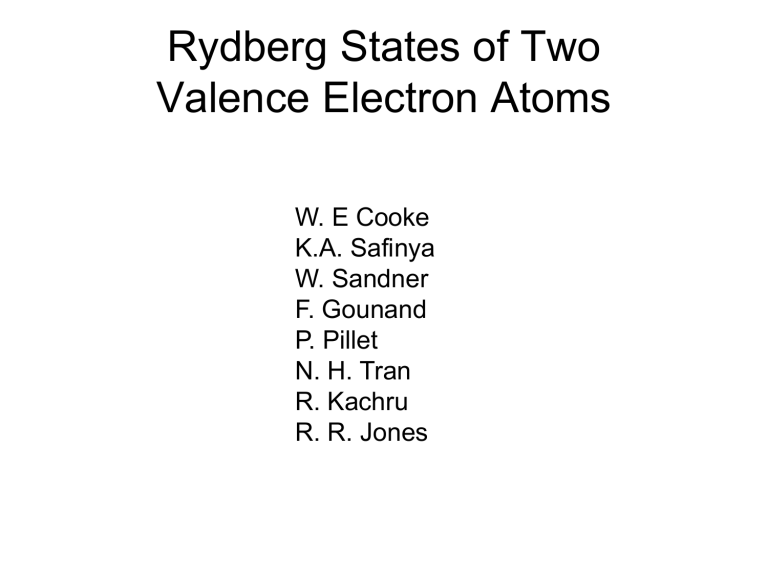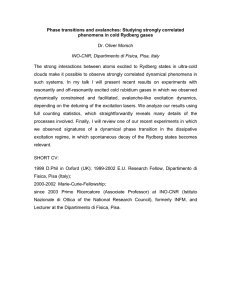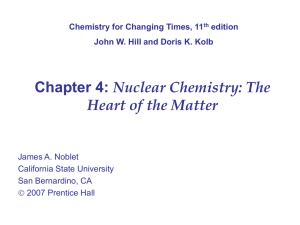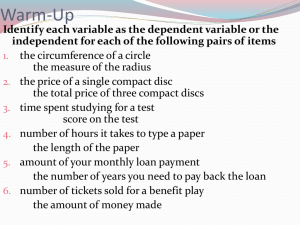two electrons

Rydberg States of Two
Valence Electron Atoms
W. E Cooke
K.A. Safinya
W. Sandner
F. Gounand
P. Pillet
N. H. Tran
R. Kachru
R. R. Jones
Perturbations of bound Rydberg states
Interactions with doubly excited states
Autoionization
Excitation of autoionizing states
Effective quantum numbers of the Ba 6snd states near n=25 a Lu-Fano plot showing the perturbation of energy levels n=21 n=27
The interaction with the 5d7d state perturbs the 6snd series
6snd
5d7d
Higher lying levels are pushed up and lower lying ones pushed down.
The properties of the 6snd states are also perturbed.
The slope of the Lu-Fano plot gives the character of the states y = A y s 6 snd
+ A y d 5 dnd
The squared amplitude ratio is given by the derivative of the Lu Fano plot
A d
2
-
=
2
A d s d n n d s
It is a level crossing problem.
No interaction(----)
A
2
2
A
1
2 large
A 2
2
A
1
2 small
Effective quantum numbers of the Ba 6snd states near n=25 a Lu-Fano plot n=21 n=27
5d7d
Both level shifts and perturbed lifetimes are due to the interaction of the Rydberg states with a state converging to a higher limit.
They are related to autoionization above the limit
White 1934
The similarity of series perturbations to autoionization the phenomenon of Forced Autoionization-Sandner et al
Forced Autoionization Sandner et al q=0 q=∞
Spectra taken via paths A and B on zero field and 4.8 kV/cm
Path A Path B q=∞ q=0
Ba two electrons outside a closed shell Ba ++ core
Ba + is isoelectronic to Cs, one electron outside the closed shell core, and the energy levels are similar.
6d
7s
6p
5d
6s
Ba is simpler than He since the ion levels are nondegenerate.
To each of these Ba + levels we add the second electron, producing the energy levels shown below.
We can write the Hamiltonian for the Ba atom, ignoring spin, as
H
H
0
H
0
H
1
1
2
2
2
2
2
f ( r
1
)
1 r
2
H
1
f ( r
2
)
1 r
2
1 r
12
Where r
1 and r
2 are the positions of the two electrons, r
12 is their separation, and f(r)
Is the potential an electron feels from the Ba ++ ion. As r→∞ f(r)→2/r.
If we use only H
0 the Schrodinger equation
H
0
( r
1
, r
2
) is separable.
W
( r
1
, r
2
)
1
2
2
f ( r
1
)
( r
1
)
W
1
( r
1
)
Ba +
2
2
2
( r
1
, r
2
)
1
( r
2
)
W
2
( r
2
) r
2
n
m
( r
1
)
n m
( r
2
)
W
W
1
W
2
W n
1
2 n
2 hydrogen
Without the coupling between the electrons provided by H
1 the excited states would only decay by radiative decay of each of the two electrons.
We introduce the coupling between the electrons
H
1
f ( r
2
)
1 r
2
1 r
12
If r
1
< r
2 we can use f(r
2
)=2/r
2 and write H
1 as
H
1
1 r
2
1 r
12
H
1
r
1 r
2
2
P
1
(cos
12
)
r
1
2 r
2
3
P
2
(cos
12
)....
Interaction between the dipole of the core and the field from the outer electron
Interaction between the quadrupole of the core and the field gradient from the outer electron
H
1 introduces the coupling, between states of the same parity and angular momentum, leading to both series perturbations and autoionization.
6s 6p
The 6pnd state is coupled to the 6s εf and 6sεp continua by the dipole coupling.
It is also coupled to continua by the quadrupole coupling, which we ignore for simplicity.
Autoionization broadens a level coupled to a continuum
The full width at half maximum is the autoionization rate
2
6 pnd r
1 r
2
2
P
1
(cos
12
) 6 s
f
2
There is also a phase shift of the continuum
The autoionization rate is given by Fermi’s golden rule, for example, the
Autoionization rate from the 6pnd state to the 6s εf continuum is
2
2
6 pnd r
1 r
2
2
P
1
(cos
12
) 6 s
f
The continuum state is normalized per unit energy.
This expression is a product of an angular factor, of order 1, and two radial matrix elements
6 p r
1
6 s
5 a
0 nd
1 r
2
2
f
n
1
3 / 2
From the latter we can see that the autoionization rates scale as 1/n 3
The matrix element for the outer electron, 2, depends on the small r part of its wavefunction, which is why it has the 1/n 3/2 scaling.
Due to the centrifugal barrier which keeps high ℓ electrons from the core, autoionization rates fall rapidly with ℓ.
A simple classical picture of autoionization
Each time the Rydberg electron comes by the core it has a finite probability of superelastic scattering, deexciting the core from 6p to 6s and leaving with its energy
The frequency with which the elecron comes to the core is 1/n 3
The autoionization rate is thus proportional to 1/n 3
How likely the outer electron is to deexcite the core on an orbit depends on the eccentricity of the orbit. Hence the ℓ dependence.
Absorption spectrum of Barium ground state atoms, showing the autoionizing
6pns and 6pnd states converging to both the 6p
1/2 and 6p
3/2 limits.
The spectrum is composed of odd, certainly not Lorentzian, shapes superimposed on a non zero background
There are two interfering pathways to the continuum, direct continuum excitation and excitation of the autoionizing state.
The result is a Fano profile.
6s6s
0
There are two excitation amplitudes, to the broadened discrete state, and to the continuum, which are added, then squared, to obtain the transition probability.
discrete continuum
Photon energy
The ratio of the discrete to the continuum amplitudes is q, which defines the lineshape.
The lineshapes are as shown.
q=∞ and q=0 are Lorentzian
Peaks and dips. Any other q results
In the asymmetric Fano profiles shown.
They are observed in many contexts.
Excitation of Autoionizing states from the Rydberg states
Isolated Core Excitation
With the last laser the ion 6s-6p transition is excited
The outer electron is a spectator.
The Fano q parameter is infinity. Lorentzian lines
We ignore the direct continuum excitation. Why?
The 6s-6p transition is the strongest transition in the Ba + ion. It is spread over the width of the 6p15d state, yielding a cross section of 10 -13 cm 2 .
The direct photoionization of the 15d state has a cross section of 10 -22 cm 2
detector atoms ions lasers lasers
0 1
Time ( µs)
Field pulse
Ion signal
Detect the ions from the rapid decay of the autoionizing
6p15d state as the third laser frequency is swept.
The result: a Lorentzian line centered on the 6p15d state
It is straightforward to determine the width, 15 cm -1 and the energy.
Two photon resonance due to third laser.
By changing the bound nd state it is straightforward to confirm the 1/n 3 dependence of the autoionization rate.
Autoionization widths of the Ba 6pnd states
It is straightforward to populate the low ℓ 6snℓ bound states to study their
Autoionizing 6pnℓ analogues, but can we study the higher ℓ states as well?
6sns
6snp
6snd
?
6snℓ
6s6p
6s6s
The Stark switching technique – excite a bound Stark state. Reduce the field
Adiabatically to zero, producing the desired high ℓ 6snℓ state.-Freeman and Kleppner
Field ramps lasers
0 1
Time ( µs)
Ion signal
Pruvost et al, Jones
Recordings of the 6s13ℓ to 6p
1/2
13ℓ and 6s13ℓ to 6p
3/2
13ℓ transitions for different ℓ
Splitting of the 6p
3/2
13ℓ states is due to the quadrupole interaction of H
1
Pruvost et al
Scaled Decay rates, n 3 Γ, in atomic units of the Ba 6p
1/2
Showing the rapid decrease with ℓ
12ℓ states
Radiative decay rate of the 6p ion
Simple time domain classical picture of autoionization
If the probability of superelastic scattering per orbit is 60% you would expect in the time domain to see the population decay in linear segments, one per orbit, and the rate to decrease like a stairstep.
Jones et al time
Excite atoms from the Ca 4snd
State to the 4pn state with a fs laser
Monitor the population by pumping 4pnd atoms to 4dnd with another fs laser
And detecting 7.1 eV electrons
The lines are at the Kepler periods
Linear piecewise decay
Can we use the core transition to manipulate bound Rydberg atoms?
Yes, if we can avoid autoionization.
The radiative decay rate is the decay rate of the Ba
+
6p state,
1.6x10
8
s
-1
.
The autoionization rates decrease with n and ℓ
6p
1/2
12ℓ decay rates
Autoionization
100
10
1
0.1
radiative ℓ=10 ℓ
6p
1/2
28ℓ decay rates
10
1
0.1
0.01
autoionization ℓ=7 radiative ℓ
For high ℓ many excitations
Possible without autoionization
Cooling, trapping, and imaging of high n, high ℓ states using the core transition
6p
1/2
28ℓ>10
493 nm
6s28ℓ>10
Imaging an Interacting Rydberg
Gas —Killian et al Rice
Populate Sr 5s50s and drive the core transition ai
5p50s
5p50ℓ
493 nm
5s50ℓ
5s50s fluorescence
5p
Sr +
5s
5s5s
5s5p
Imaging an Interacting Rydberg
2 m s excitation time ( m s)
0.6
Gas
2.9
5s50s
1 S
0
5s50d
1 D
5s5p
P
1
• Penning ionization
• Collisiona l l-mixing
• electroncollision ionization
• autoionization
5s
2
P
1/2
422 nm
5.1
5s
2
S
0
Sr neutral evolution time
5s
Sr
+
ion or
2
S
1/2
Sr Rydberg core
7.3
Killian et al
3 mm
Cooling or trapping of high n, high ℓ states using the core transition
6p
1/2
28ℓ>10
493 nm
5d
3/2
28ℓ>10
6s28ℓ>10
The autoioization rates of 6p
1/2 and 5d
3/2
28ℓ>10
28ℓ>10 states are similar.
Radiative decay of the latter is 10 6 slower.
Cooling, trapping, and imaging of high n, high ℓ states using the core transition
6p
1/2
28ℓ>10
493 nm
650 nm
5d
3/2
28ℓ>10
6s28ℓ>10
The autoioization rates of 6p
1/2 and 5d
3/2
28ℓ>10
28ℓ>10 states are similar.
Radiative decay of the latter is 10 6 slower.
Far off resonance trap based on ICE
6s15d
6p15d
Laser red detuned from 455 nm
The low power spectrum: a Lorentzian line centered on the 6p15d state
Two photon resonance due to third laser.
Third laser power 50x higher
The spectrum is due to the ion transition with a spectator electron which is projected from the bound state onto the autoionizing state.
The squared 6s15d-6p15d matrix element, and thus the optical cross section, is
6 s 15 d m
6 p
2 d
2
6 s m
6 p
2
A
2
2
15 d
2 d
2
Ion dipole matrix element
Spectral density of the autoionizing state
Overlap integral
The center of the cross section looks
Like the spectral density.
At high power the center of the cross section is saturated, and the wings become apparent.
The zeroes come from the overlap
Integral.
Calculated spectrum for high laser power
Rydberg states of two electron atoms provide easy access to doubly excited autoionizing states.
There are new possibilities for detecting and trapping Rydberg atoms.








